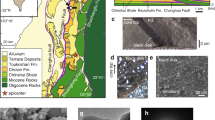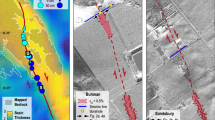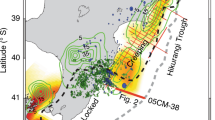Abstract
Determining the seismic fracture energy during an earthquake and understanding the associated creation and development of a fault zone requires a combination of both seismological and geological field data1. The actual thickness of the zone that slips during the rupture of a large earthquake is not known and is a key seismological parameter in understanding energy dissipation, rupture processes and seismic efficiency. The 1999 magnitude-7.7 earthquake in Chi-Chi, Taiwan, produced large slip (8 to 10 metres) at or near the surface2, which is accessible to borehole drilling and provides a rare opportunity to sample a fault that had large slip in a recent earthquake. Here we present the retrieved cores from the Taiwan Chelungpu-fault Drilling Project and identify the main slip zone associated with the Chi-Chi earthquake. The surface fracture energy estimated from grain sizes in the gouge zone of the fault sample was directly compared to the seismic fracture energy determined from near-field seismic data3,4. From the comparison, the contribution of gouge surface energy to the earthquake breakdown work is quantified to be 6 per cent.
This is a preview of subscription content, access via your institution
Access options
Subscribe to this journal
Receive 51 print issues and online access
$199.00 per year
only $3.90 per issue
Buy this article
- Purchase on Springer Link
- Instant access to full article PDF
Prices may be subject to local taxes which are calculated during checkout




Similar content being viewed by others
References
Kanamori, H. The diversity of the physics of earthquakes. Proc. Jpn. Acad. 80, 297–316 (2004)
Ma, K-F. et al. The Chi-Chi, Taiwan earthquake: large surface displacements on an inland thrust fault. Eos 80, 605 (1999)
Ma, K-F. et al. Spatial and temporal distribution of slip for the 1999 Chi-Chi, Taiwan earthquake. Bull. Seismol. Soc. Am. 91, 1069–1087 (2001)
Ji, C. et al. Slip history dynamic implications of the 1999 Chi-Chi, Taiwan, earthquake. J. Geophys. Res. 108 2412 doi: 10.1029/2002JB001764 (2003)
Yue, L. F., Suppe, J. & Hung, J-H. Structure geology of a classic thrust belt earthquake: the 1999 Chi-Chi earthquake Taiwan (Mw=7.6). J. Struct. Geol. 27, 2058–2083 (2005)
Wang, C-Y. Detection of a recent earthquake fault by the shallow reflection seismic method. Geophysics 67, 1465–1473 (2002)
Wang, C-Y., Li, C-L. & Yen, H-Y. Mapping the northern portion of the Chelungpu fault, Taiwan by shallow reflection seismics. Geophys. Res. Lett. 29 doi: 10.1029/2001GL014496 (2002)
Heermance, R., Shipton, Z. K. & Evans, J. P. Fault structure control on fault slip and ground motion during the 1999 rupture of the Chelungpu fault, Taiwan. Seismol. Soc. Am. Bull. 93, 1034–1050 (2003)
Tanaka, H. et al. Initial science report of shallow drilling penetrating into the Chelungpu fault zone, Taiwan. Terr. Atmos. Ocean. Sci. 113, 227–251 (2002)
Sibson, R. H. Thickness of the seismic slip zone. Bull. Seismol. Soc. Am. 93, 1169–1178 (2003)
Tanaka, H. et al. Whole fault zone architecture and its relation to thin slip layer activated by 1995 Kobe earthquake detected at 1140 m depth in the drilled core penetrating the Nojima fault. J. Geophys. Res. (submitted).
Gratier, J-P., Favreau, P. & Renard, F. Modeling fluid transfer along California faults when integrating pressure solution crack sealing and compaction process. J. Geophys. Res. 108 doi: 10.1029/2001JB000380 (2003)
Chester, J. S., Chester, F. M. & Kronenberg, A. K. Fracture surface energy of the Punchbowl Fault, San Andreas system. Nature 437, 133–136 (2005)
Sammis, C., King, G. & Biegel, R. The kinematics of gouge deformation. Pure Appl. Geophys. 125, 777–812 (1987)
Otsuki, K., Monzawa, N. & Nagase, T. Fluidization and melting of fault gouge during seismic slip: Identification in the Nojima fault zone and implications for focal earthquake mechanisms. J. Geophys. Res. 108, B4 2192 doi: 10.1029/2001JB001711 (2003)
Kadono, T. et al. Surface roughness of alumina fragments caused by hypervelocity impact. Planet. Space Sci. 54, 212–215 (2006)
Scholz, C. H. in The Mechanics of Earthquakes and Faulting 158–167 (Cambridge Univ. Press, Cambridge, UK, 2002)
Lawn, B. Fracture of Brittle Solids 2nd edn 1–378 (Cambridge Univ. Press, New York, 1993)
McGarr, A., Spottiswoode, S. M. & Gay, N. C. Observations relevant to seismic driving stress, stress drop, and efficiency. J. Geophys. Res. 84, 2251–2261 (1979)
Wilson, B., Dewers, T., Reches, Z. & Brune, J. Particle size and energetics of gouge from earthquake rupture zones. Nature 434, 749–752 (2005)
Andrews, D. J. Test of two methods for faulting in finite-difference calculations. Bull. Seismol. Soc. Am. 89, 4931–4937 (1999)
Tinti, E., Spudich, P. & Cocco, M. Earthquake fracture energy inferred from kinematic rupture models on extended faults. J. Geophys. Res. 110, B12303 doi:10.1029/2005JB003644. (2005)
Zhang, W. B. et al. Heterogeneous distribution of the dynamic source parameters of the 1999 Chi-Chi, Taiwan, earthquake. J. Geophys. Res. 108 doi: 10.1029/2002JB001889 (2003)
Abercrombie, R. E. & Rice, J. R. Can observation of earthquake scaling constrain slip weakening? Geophys. J. Int. 162, 406–424 (2005)
Wibberley, C. A. J. & Shimamoto, T. Earthquake slip weakening and asperities explained by thermal pressurization. Nature 436, 689–692 (2005)
Tanaka, H. et al. Frictional heat from faulting of the 1999 Chi-Chi, Taiwan earthquake. Geophys. Res. Lett. 33 doi: 10.1029/2006GL026673 (2006)
Brodsky, E. & Kanamori, H. Elastohydrodynamic lubrication of faults. J. Geophys. Res. 106, 16357–16373 (2001)
Ma, K-F. et al. Evidence for fault lubrication during the 1999 Chi-Chi, Taiwan, earthquake (Mw7.6). Geophys. Res. Lett. 30, 1244 doi:10.1029/2002GL015380. (2003)
Husseini, M. I. & Randall, M. J. Rupture velocity and radiation efficiency. Seismol. Soc. Am. Bull. 660, 1173–1187 (1976)
Venkataraman, A. & Kanamori, H. Effect of directivity on estimates of radiated seismic energy. J. Geophys. Res. 109 doi: 10.1029/2003JB002548 (2004)
Acknowledgements
We thank the working group of TCDP, including the drilling company FangYu and WonDa, the on-site assistants and more than 60 participating students from NCU and NTU, S. T. Huang at CPC for core storage and splitting, Y.-M. Chen of the NSRRC for taking TEM and TXM images, and K. S. Liang of the NSRRC. We also thank M. Zoback, S. Hickman, W. Ellsworth and H. Ito for discussion before and during drilling. We also thank H. Kanamori and E. Brodsky for discussions and a review of an early version of this paper. This project was supported by the NSC, Taiwan, and partially supported by the ICDP. Author Contributions K.-F.M., paper writing and project planning. H.T., core observation, data analysis and project planning. S.-R.S., petrographic and XRD analysis and project planning. C.-Y.W., J.-H.H., Y.-B.T., W.S., project planning. J.M., paper preparation. Y.-F.S., TEM and TXM taken at NSRRC and data analysis. E.-C.Y. and H.S., on-site geologists during coring. L.-W.K. and H.-Y.W., on-site assistants.
Author information
Authors and Affiliations
Corresponding author
Ethics declarations
Competing interests
Reprints and permissions information is available at www.nature.com/reprints. The authors declare no competing financial interests.
Supplementary information
Supplementary Table 1
The list of the observed particle sizes in diameters and the numbers of grains observed in each grain clast. (PDF 30 kb)
Supplementary Figure 1
SEM images of (a) 1 μm, (b) 100 μm and (c) OM images of 100 μm. (PDF 40151 kb)
Supplementary Figure 2
Mineral composition of the major slip zone from X-ray diffraction for semi-quantitative analysis as composed of about 70% of quartz, 5% of Feldspar, and 25% of clay minerals with indication of Quartz (Q). (PDF 203 kb)
Supplementary Methods
This file contains additional details of the methods used in this study. (DOC 22 kb)
Rights and permissions
About this article
Cite this article
Ma, KF., Tanaka, H., Song, SR. et al. Slip zone and energetics of a large earthquake from the Taiwan Chelungpu-fault Drilling Project. Nature 444, 473–476 (2006). https://doi.org/10.1038/nature05253
Received:
Accepted:
Issue Date:
DOI: https://doi.org/10.1038/nature05253
This article is cited by
-
Dynamic Pulverization of Rock Under Triaxial Static-Stress and High-Rate Shearing
Rock Mechanics and Rock Engineering (2024)
-
Displacement Distribution Patterns and Governing Factors of Rock Mass in a Stable Creeping Fault Zone
Soil Mechanics and Foundation Engineering (2022)
-
Mineralogy and structures below Deccan Traps: Evidences from scientific drilling in the Koyna seismogenic zone, India
Journal of Earth System Science (2022)
-
Fault reactivation with rapid slip along subsidiary faults in the Yangsan Fault zone, SE Korea
Geosciences Journal (2022)
-
Frictional heating in a thick fault zone with empirical slip-weakening friction: implications for slip parameter estimation from temperature observations in deep fault drilling
Progress in Earth and Planetary Science (2021)
Comments
By submitting a comment you agree to abide by our Terms and Community Guidelines. If you find something abusive or that does not comply with our terms or guidelines please flag it as inappropriate.



